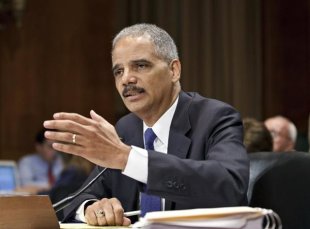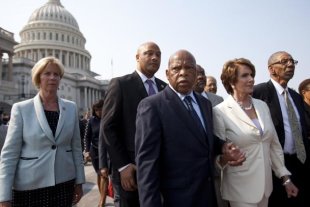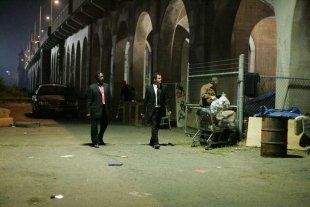WASHINGTON (AP) — Millions across the mid-Atlantic region sweltered Saturday in the aftermath of violent storms that pummeled the eastern U.S. with high winds and downed trees, killing at least 13 people and leaving 3 million without power during a heat wave.
Power officials said the outages wouldn't be repaired for several days to a week, likening the damage to a serious hurricane. Emergencies were declared in Maryland, West Virginia, Ohio, the District of Columbia and Virginia, where Gov. Bob McDonnell said the state had its largest non-hurricane outage in history, as more storms threatened. "This is a very dangerous situation," the governor said.
In West Virginia, 232 Amtrak passengers were stranded Friday night on a train that was blocked on both sides by trees that fell on the tracks, spending about 20 hours at a rural station before buses picked them up. And in Illinois, storm damage forced the transfer of dozens of maximum-security, mentally ill prisoners from one prison to another.
In some Virginia suburbs of Washington, emergency 911 call centers were out of service; residents were told to call local police and fire departments. Huge trees fell across streets in Washington, leaving cars crunched up next to them, and onto the fairway at the AT&T; National golf tournament in Maryland. Cell phone and Internet service was spotty, gas stations shut down and residents were urged to conserve water until sewage plants returned to power.
The outages were especially dangerous because they left the region without air conditioning in an oppressive heat. Temperatures soared to highs in the mid-90s in Baltimore and Washington, where it had hit 104 on Friday.
"I've called everybody except for the state police to try to get power going," said Karen Fryer, resident services director at two assisted living facilities in Washington. The facilities had generator power, but needed to go out for portable air conditioning units, and Fryer worried about a few of her 100 residents who needed backup power for portable oxygen.
The stranded train passengers spent more than 20 hours on the train after they stopped around 11 p.m. on Friday at a station near rural Prince, W.Va.
Brooke Richart, a 26-year-old teacher from New York City, said she was among the stuck passengers. To pass the time, she read half a book, talked to the people around her and took walks outside the train.
"We tried to walk up the side of the mountain to see if anyone could get cell service. We didn't have cell service the entire time we were down there," she said.
Amtrak spokesman Steve Kulm said the passengers were picked up by buses, which departed by 8:20 p.m. Saturday. The buses will travel to the stations along the original route, dropping off passengers along the way.
The stranded passengers on the train bound from New York to Chicago had lights, air conditioning and food the entire time, Kulm said. He wasn't aware of any injuries or health problems.
Richart was traveling to her hometown of Cincinnati. She said the ride had mostly been smooth, with a few delays, before they stopped in Prince. The storm had already passed through by the time they stopped.
She said the train attendants and her fellow passengers were extremely nice — watching each others' children and sharing food.
She said her family had a hard time figuring out where she in conversations with Amtrak customer service representatives. But by the time the buses arrived, her father had also come to pick her up and drive her the rest of the way.
"It gets a little trying," she said. "Thankfully we could go in and out of the train because we were there so long. If you wanted to stretch your legs or take a walk, you could do that."
The storm did damage from Indiana to New Jersey, although the bulk of it was in West Virginia, Washington and suburban Virginia and Maryland. At least six of the dead were killed in Virginia, including a 90-year-old woman asleep in bed when a tree slammed into her home. Two young cousins in New Jersey were killed when a tree fell on their tent while camping. Two were killed in Maryland, one in Ohio, one in Kentucky and one in Washington.
Illinois corrections officials transferred 78 inmates from a prison in Dixon to the Pontiac Correctional Center after storms Friday night caused significant damage, Department of Corrections spokeswoman Stacey Solano said.
No one was injured, Solano said. Generators are providing power to the prison, which is locked down, confining remaining inmates to their cells.
Utility officials said it could take at least several days to restore power to all customers because of the sheer magnitude of the outages and the destruction. Winds and toppled trees brought down entire power lines, and debris has to be cleared from power stations and other structures. All of that takes time and can't be accomplished with the flip of a switch.
"This is very unfortunate timing," said Myra Oppel, a spokeswoman for Pepco, which reported over 400,000 outages in Washington and its suburbs. "We do understand the hardship that this brings, especially with the heat as intense at is. We will be working around the clock until we get the last customer on."
Especially at risk were children, the sick and the elderly. In Charleston, W.Va., firefighters helped several people using walkers and wheelchairs get to emergency shelters. One of them, David Gunnoe, uses a wheelchair and had to spend the night in the community room of his apartment complex because the power — and his elevator — went out. Rescuers went up five floors to retrieve his medication.
Gunnoe said he was grateful for the air conditioning, but hoped power would be restored so he could go home.
"It doesn't matter if it's under a rock some place. When you get used to a place, it's home," he said.
More than 20 elderly residents at an apartment home in Indianapolis were displaced when the facility lost power due to a downed tree. Most were bused to a Red Cross facility to spend the night, and others who depend on oxygen assistance were given other accommodations, the fire department said.
Others sought refuge in shopping malls, movie theaters and other places where the air conditioning would be turned to "high."
In Richmond, Va., Tracey Phalen relaxed with her teenage son under the shade of a coffee-house umbrella rather than suffer through the stifling heat of her house, which lost power.
"We'll probably go to a movie theater at the top of the day," she said.
Phalen said Hurricane Irene left her home dark for six days last summer, "and this is reminiscent of that," she said.
Others scheduled impromptu "staycations" or took shelter with friends and relatives.
Robert Clements, 28, said he showered by flashlight on Friday night after power went out at his home in Fairfax, Va. The apartment complex where he lives told his fiancee that power wouldn't be back on for at least two days, and she booked a hotel on Saturday.
Clements' fiancee, 27-year-old Ann Marie Tropiano, said she tried to go to the pool, but it was closed because there was no electricity so the pumps weren't working. She figured the electricity would eventually come back on, but she awoke to find her thermostat reading 81 degrees and slowly climbing. Closing the blinds and curtains didn't help.
"It feels like an oven," she said.
At the AT&T; National in Bethesda, Md., trees cracked at their trunks crashed onto the 14th hole and onto ropes that had lined the fairways. The third round of play was suspended for several hours Saturday and was closed to volunteers and spectators. Mark Russell, the PGA Tour's vice president of rules and competition, couldn't remember another time that a tour event was closed to fans.
"It's too dangerous out here," Russell said. "There's a lot of huge limbs. There's a lot of debris. It's like a tornado came through here. It's just not safe."
The outages disrupted service for many subscribers to Netflix, Instagram and Pinterest when the storm cut power to some of Amazon Inc.'s operations. The video and photo sharing services took to Twitter and Facebook to update subscribers on the outages. Netflix and Pinterest had restored service by Saturday afternoon.
___
Associated Press writers Vicki Smith in Morgantown, W.Va.; Larry O'Dell in Richmond, Va.; Pam Ramsey in Charleston, W.Va.; Norman Gomlak and Jonathan Drew in Atlanta; Jeffrey McMurray in Chicago; Doug Ferguson in Bethesda, Md.; and Rebecca Miller in Philadelphia contributed to this report.





